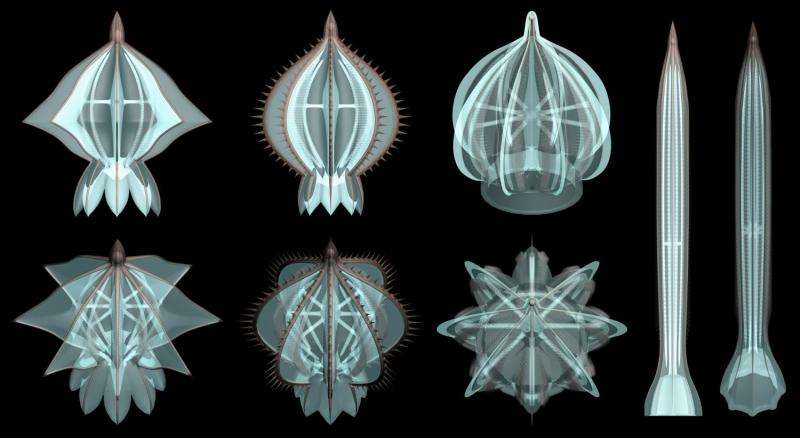July 13, 2015 report
New fossils show ancient comb jellies had skeleton parts

(Phys.org)—A team of researchers with members from several institutions in China and one in the U.S. has found evidence that shows that ancient comb jellies had skeleton parts. In their paper published in the journal Science Advances, the team describes comb jelly ancestor fossils that were found in rock formations in China, the skeleton parts they found and theories regarding possible reasons for those parts.
Contrary to popular belief, though they may look a lot like them, comb jellies are not jellyfish, instead they belong to the phylum Ctenophora. Scientists have found over a hundred species of the creature in its modern form and not one of them has any sort of skeleton. That is why the find in China is so surprising, an early relative that lived approximately 520 million years ago (during the Cambrian Period), did have some bony parts.
The fossils were found at the famous Chengjiang site, embedded in rock—in all, six species were found among over three dozen specimens, each with some amount of hard skeleton material. The bone-like material was shaped like spokes, struts or plates. The plates appeared to cover the bodies, serving apparently, as a barrier against predators, or perhaps some other harmful environmental factor. The researchers cannot say for sure what the bone-like material was made of but suspect it was likely chitin or something similar, or even a carbonate rich mineral material. Also, because of the arrangement of the spokes or struts, the team suggests that the bones could have served a dual purpose, structural support and as a defense mechanism. In a bit of a twist, if the skeletal parts were indeed meant as a protection mechanisms, it does not appear to have worked out—the fossil species found in the rocks never made it to the modern age, they all died out.
The finding also appears to contradict theories (based on DNA models) that have suggested ancient comb jellies had tentacles—none of the fossils had any sign of them. On the other hand, finding they had skeletons suggests they faced unknown threats, which should present a new avenue for study.
More information: A vanished history of skeletonization in Cambrian comb jellies, Science Advances 10 Jul 2015: Vol. 1, no. 6, e1500092. DOI: 10.1126/sciadv.1500092
Abstract
Ctenophores are traditionally regarded as "lower" metazoans, sharing with cnidarians a diploblastic grade of organization. Unlike cnidarians, where skeletonization (biomineralization and sclerotization) evolved repeatedly among ecologically important taxa (for example, scleractinians and octocorals), living ctenophores are characteristically soft-bodied animals. We report six sclerotized and armored ctenophores from the early Cambrian period. They have diagnostic ctenophore features (for example, an octamerous symmetry, oral-aboral axis, aboral sense organ, and octaradially arranged ctene rows). Unlike most modern counterparts, however, they lack tentacles, have a sclerotized framework, and have eight pairs of ctene rows. They are resolved as a monophyletic group (Scleroctenophora new class) within the ctenophores. This clade reveals a cryptic history and sheds new light on the early evolution of this basal animal phylum. Skeletonization also occurs in some other Cambrian animal groups whose extant members are exclusively soft-bodied, suggesting the ecological importance of skeletonization in the Cambrian explosion.
Journal information: Science Advances
© 2015 Phys.org




















